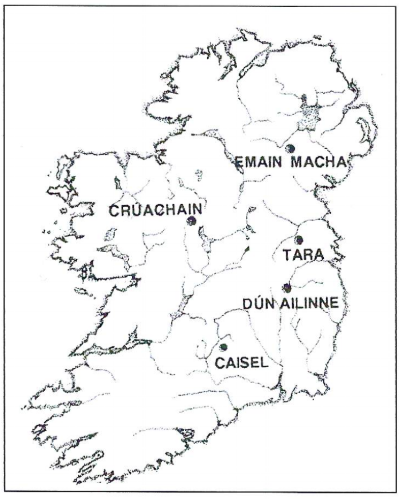History of the Hill of Tara
Ireland’s Sacred Hill
The Hill of Tara was once the ancient seat of power in Ireland – 142 kings are said to have reigned ancient Ireland during prehistoric and historic times. Tara’s story is Ireland’s story. Tara’s symbols are Ireland’s symbols - the harp, the shamrock, the ancient gold. Prominent in our oldest myths and legends, the hill has been at the center of things Irish since the ancient, earliest times. In some mysterious way, Tara touches the very soul of Ireland. While its regal and heroic identity hark back to a legendary time long gone by, as a symbol Tara has survived right up to the present. Thus down the centuries great lovers of this land - like the United Irishman of 1798, or Daniel O’Connell, The Irish Liberator - have used Tara’s grassy banks as a backdrop for their dreams and their messages. - Michael Slavin, The Book of Tara
Tara’s Story
The fame of Tara is based on Legends - magical tales about successive ancient invasions, the exploits of pre historic kings and the arrival of St. Patrick at the sacred hill in 432 A.D. Through the ancient accounts of Irish folklore and stories, a magical energy exists on this sacred hill. These legendary stories are contained in the lebor Gabala Erenn or The Book of the Taking of Ireland, which was written down in various versions by monastic scribes of the eleventh to fourteenth centuries. The texts are a fascinating account of the early habitation for Ireland - a mix of oral lore and the Christian tradition of the Middle Ages.
Ancient Monuments at the Hill of Tara
The Stone of Destiny
After the Battle of Moytura in 1896 B.C., the victorious tribe of Tuatha De Danann brought four gifts with them to Tara; the Lia Fail or Stone of Destiny, the Spear of Lugh, the Sword of Nuadu and the Cauldron of Dagda. Legend has it the Stone of Destiny was believed to roar when the true king touched it or rode his chariot next to it. It’s obvious phallic symbolism may support this theory - as the true king underwent a ritual marriage with the Goddess of Sovereignty before he could rule. Today the 4000 year old Stone of Destiny is still standing on the Hill of Tara.
St. Patrick + Christianity
In 432 AD a Roman saint named St. Patrick visited the Hill of Tara to confront the Pagan King Laoghaire. According to legend, Patrick plucked a shamrock of the grassy hillside of Tara, and used the shamrock’s three leaves to explain the Church’s paradox of the Holy Trinity: the union of the Father, the Son and the Holy Spirit in one. Convinced by the stranger, King Laoghaire agreed to let St. Patrick continue his missionary work and spread Christianity throughout Ireland. Patrick did far more than convert pagan Ireland to Christianity; he popularized the faith, carefully integrating it with what he knew of Celtic mythology and Irish lore so that it was more easily assimilated.
The Mound of Hostages
As seen on the front of our Hill of Tara wine label, the Mound of Hostages is the oldest monument on the Hill of Tara. It is an ancient neolithic passage grave that to it’s creators, was the entrance to the afterlife. Like many of the other passage tombs that date back to 3500 BC, the alignment allows the morning sun to shine down the passageway twice a year during the solstices to fully illuminate the internal chamber. Excavation carried out in 1955 and 1959 found more than 200 cremated or inhumed burials.
Ancient Burial Grounds
Danny’s Grandfather and Great Grandmother are laid to rest at St. Patrick’s Church cemetery on the Hill of Tara.
Tara’s ORIGIN
Ireland was initially colonized in 1972 BC by the Fir Bolgs, a group of slaves who escaped from Greece. Tara became one of the five colonies of Ireland and the high seat to the royal king. Located 30 kilometers northwest of present day Dublin, the Hill of Tara is no more than 155m in height (508 feet), but it’s unique position at the edge of Ireland’s central lowland plain allows it to overlook miles of countryside in every direction. For the last 4,000 years, Ireland has been invaded by almost every colony or country in the western hemisphere. The Vikings, The Normans, The English, The Scottish, The French, The Spanish and .The Romans to name a few. Each battle ended with control of Tara and the rule of Ireland.
Throughout the rotation of civilizations, the Hill of Tara has remained a constant place of worship, kingship and spirituality. Today, the Hill of Tara is a UNESCO Heritage site, with several ancient monuments that remind us of the events and stories that took place on this ancient hill.
OUR CONNECTION TO TARA
Danny’s Great Uncle, Bill Tormey (in the image above), was the last person to privately own the Hill of Tara. Bill inherited the land from his father, Edward Tormey, who purchased the Hill of Tara property in 1928. Danny’s grandmother, Irene, was born in Tara, and his Father, Eamonn, grew up on the hill, charging 5 shilling for each visitor to walk the sacred land.
Our Family proudly farmed and preserved Hill of Tara from 1928 to 1974. Bill decided it was time to sell the Hill of Tara to the Irish Government and give ownership back to the people of Ireland for the first time in 900 years. Make sure to visit the Hill of Tara on your next visit to Ireland.
Any kind of farming is a labor of love. Our farming ancestors inspire us dedicate our labor and love to the land and leave it better than we found it through farming organically.






